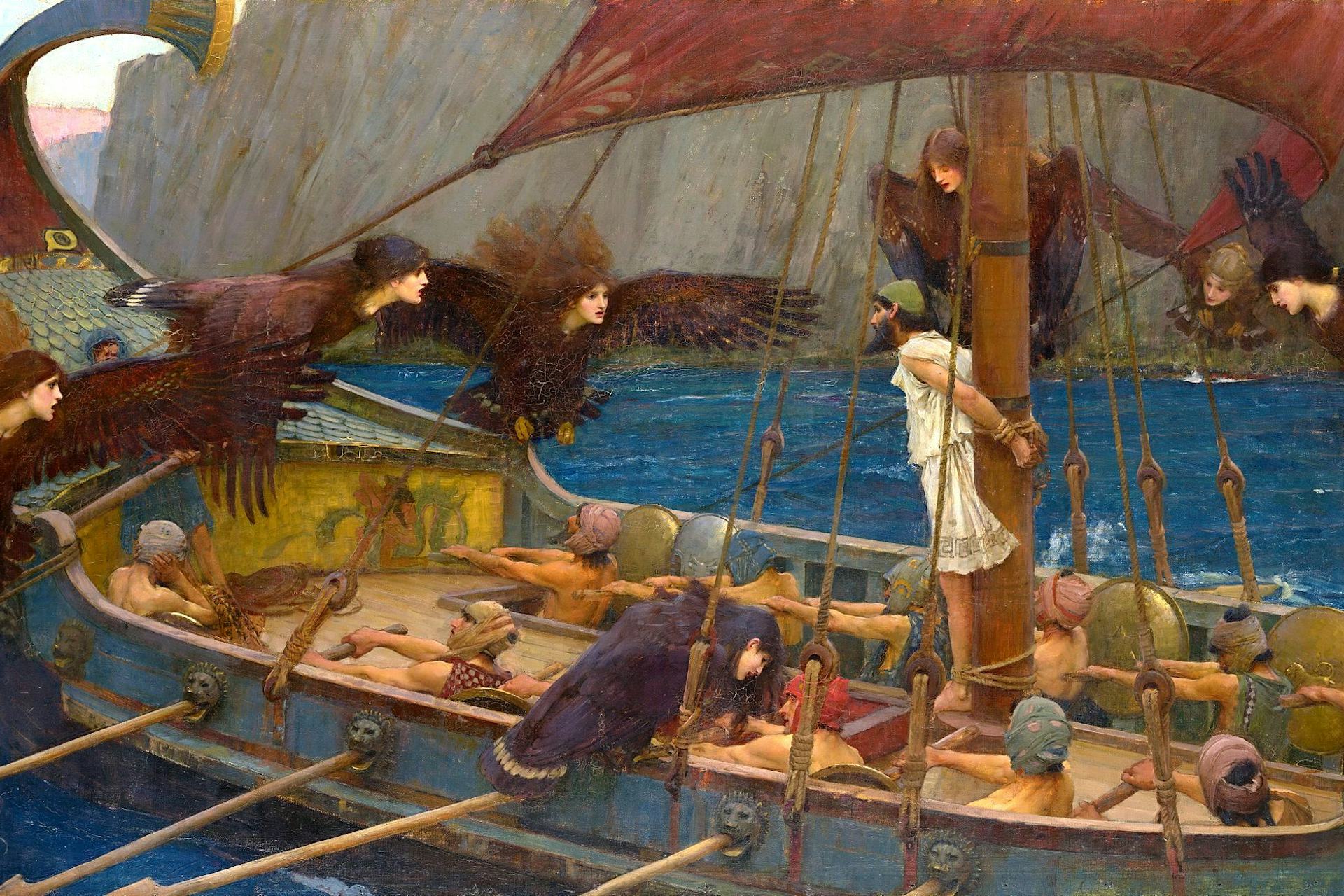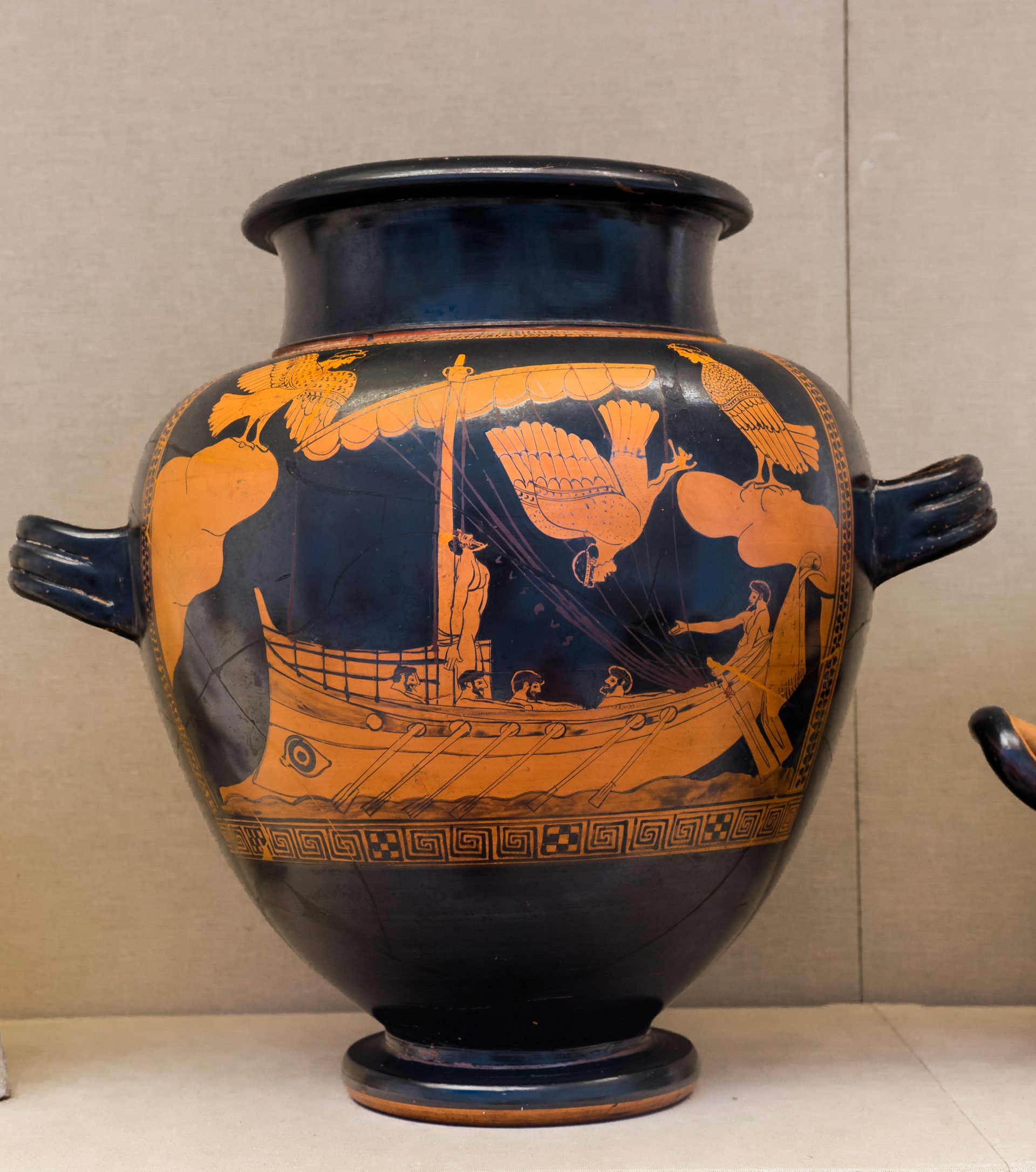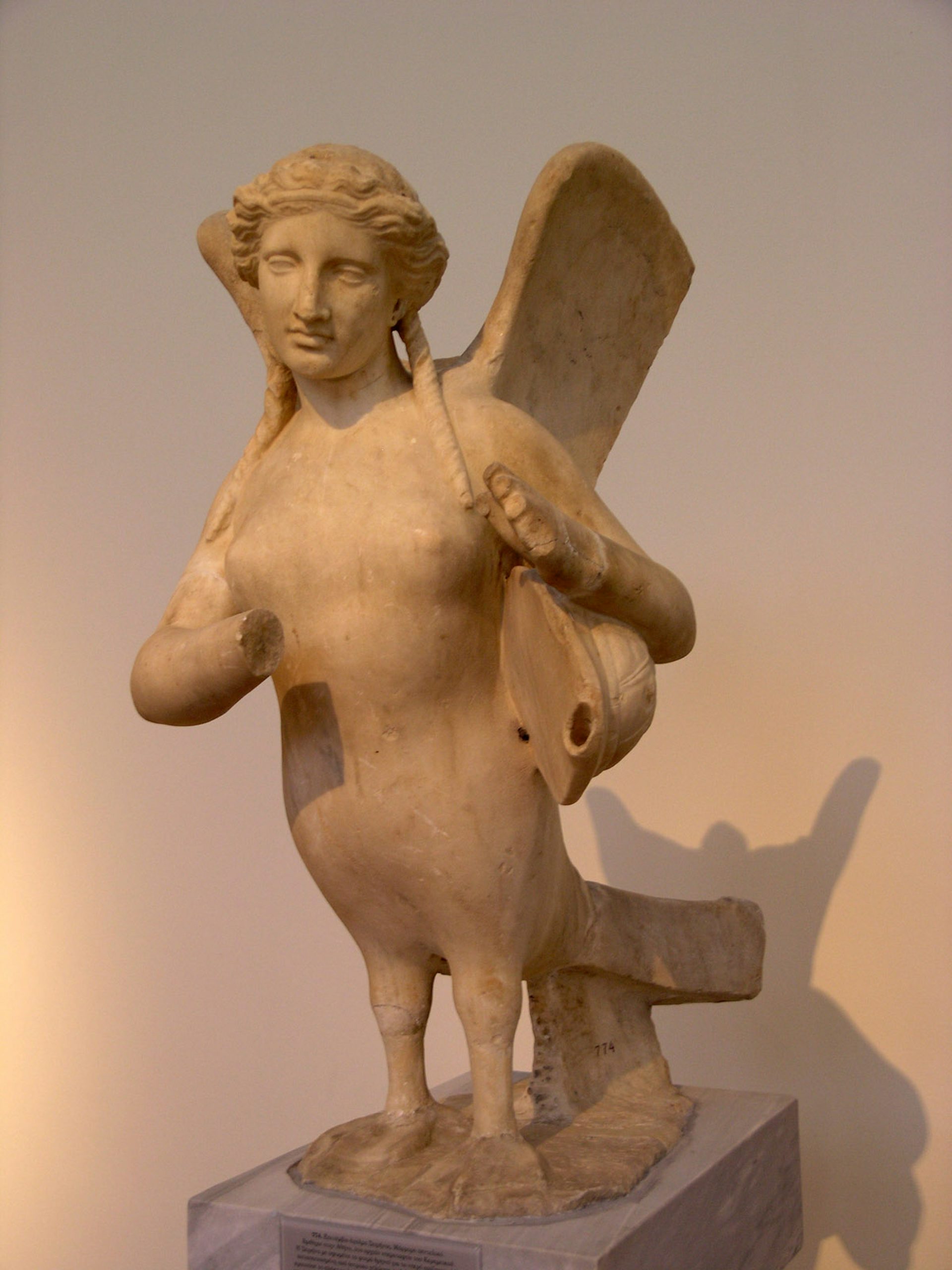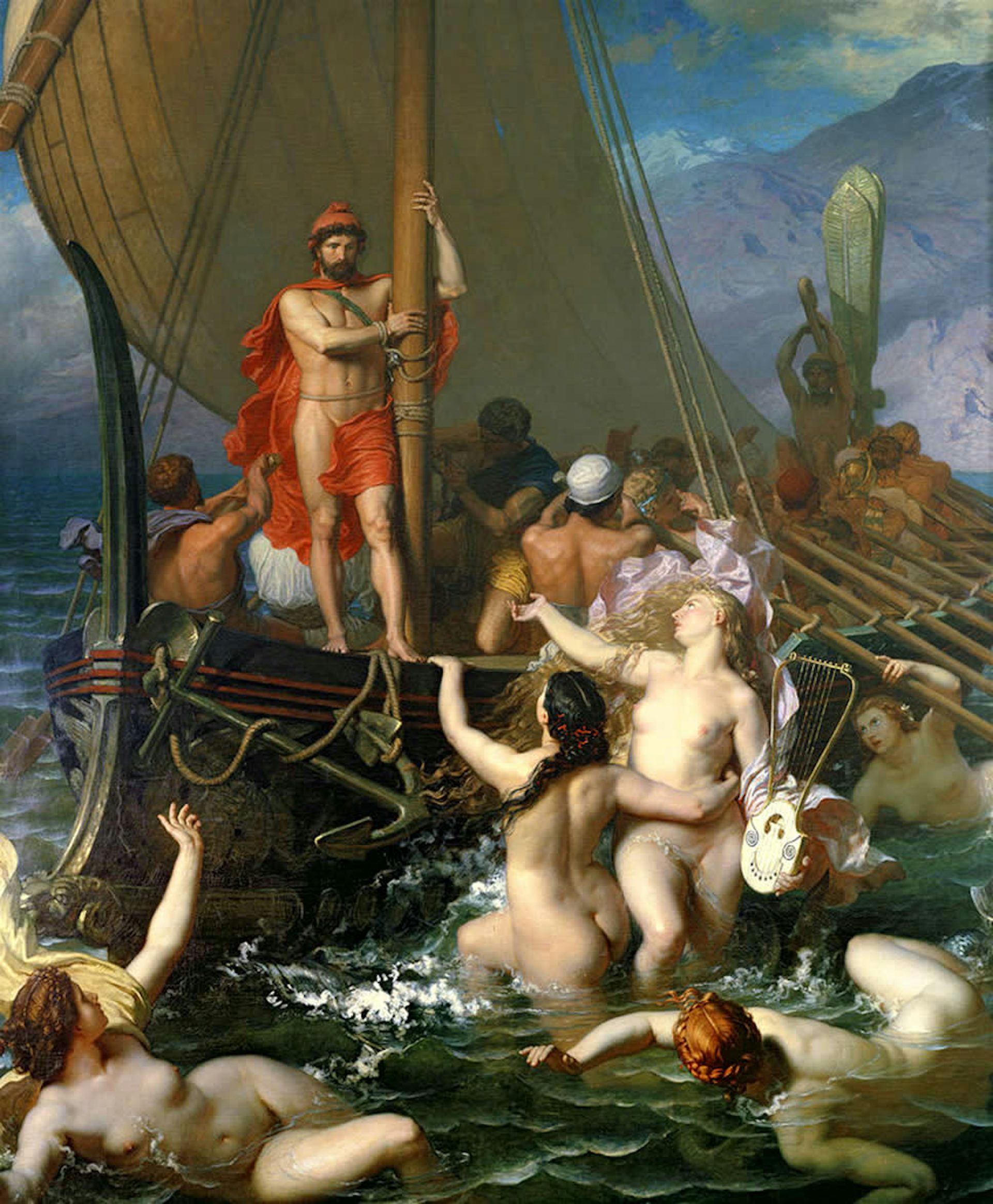Sirens

Ulysses and the Sirens by John William Waterhouse (1891)
National Gallery of VictoriaPublic DomainOverview
The Sirens, daughters of the river god Achelous, were vicious creatures, especially feared by sailors. In most representations, they had the face and torso of a beautiful woman, but the wings and lower body of a bird. Their beguiling song would cause sailors to forget home and leap into the sea to meet their death.
Powerful as the Sirens were, a few mythological heroes managed to escape them. When the Argonauts sailed past the Sirens, for example, Orpheus was able to drown out their song with his own music. Later, when Odysseus encountered them on his way home from Troy, he sealed his men’s ears with wax but was able to listen to the Sirens’ song himself by having himself bound tightly to the mast. It was sometimes said that the Sirens drowned themselves after their failure to seduce Odysseus.
Etymology
The origins of the term “Siren” (Greek Σειρήν, translit. Seirḗn; pl. “Sirens,” Greek Σειρῆνες, translit. Seirênes) are highly obscure. The name can be traced back to the Mycenaean period (ca. 1600–1050 BCE), where it was written as se-re-mo in Linear B, the syllabic script used before the invention of the Greek alphabet.
According to the standard etymological explanation, “Siren” is related to the Greek word σειρά, meaning “rope.” This would make the Sirens “the ensnaring ones.”[1]
However, some alternative etymologies have been suggested. Felix Solmsen, for example, connected the Sirens to Sirius (Σείριος, Seírios), a bright star associated with the summer. He thus posited that the Sirens had something to do with heat.[2] Wilhelm Brandenstein argued that the term is a Thracian loanword connected to the Indo-European root *ĝʰer, meaning “to delight in.”[3] Pierre Chantraine and Robert Beekes, meanwhile, claimed that the name is pre-Greek in origin.[4]
It is possible that “Siren” is not an Indo-European word at all. In the nineteenth century, scholars began suggesting a connection with the common Semitic word šyr, meaning “song.” Some added a second Semitic element, producing the term šyr ḥn, meaning “song of grace”;[5] šyr ’n, which can mean either “song of entrapment”[6] or “song of mourning,”[7] depending on how the root is interpreted; and šyr ’ymh, “song of terror.”[8] Yet another possibility is that the term comes from the Ugaritic masculine plural form šyrm, meaning “singers.”[9]
Pronunciation
English
Greek
Siren, Sirens Σειρήν (translit. Seirḗn), Σειρῆνες (translit. Seirênes) Phonetic
IPA
[SAHY-ruhn], [SAHY-ruhnz] /ˈsaɪ rən/, /ˈsaɪ rənz/
Individual Names
The earliest sources to mention the Sirens did not state their individual names, though a handful of authors did give the number of Sirens: according to Homer, there were two;[10] according to Hesiod, three;[11] and according to Plato, eight.[12]

Attic red-figure stamnos showing Odysseus and his ship passing by the Sirens, name vase of the Siren Painter (ca. 475–470 BCE). From Vulci. British Museum, London, UK.
ArchaiOptixCC BY-SA 4.0Later sources, however, went further and actually gave the names of individual Sirens—though these sources did not always agree. The most widely accepted version held that there were three Sirens, named Parthenope, Leucosia, and Ligia.[13]
Another well-known version gave the names of the three Sirens as Pisinoe, Aglaope, and Thelxiepia.[14] Other alternative trios include Aglaonoe, Aglaopheme, and Thelxiepia;[15] Thelxiope (or Thelxione), Molpe, and Aglaophonos;[16] or Teles, Molpe, and Thelxiope.[17]
Some sources, on the other hand, adhered to the early Homeric notion of a duo of Sirens and gave their names as Aglaopheme and Thelxiepia.[18]
There also appears to have been one tradition in which there were four Sirens, whose names were Aglaopheme, Thelxiepia, Pisinoe, and Ligia.[19]
Finally, a painted stamnos (liquid jar) from the early fifth century BCE depicts a Siren whose name is inscribed as “Himeropa,” but she is otherwise unknown from ancient sources.[20]
Attributes
Locales
In the Odyssey, Homer located the home of the Sirens somewhere far to the west, near the narrow strait of Scylla and Charybdis.[21] Other sources said that the Sirens lived on the island of Anthemoessa or Anthemusa (meaning “Flowery”).[22]
From an early date, it was generally assumed that the Sirens, like many of the strange creatures and gods encountered by Odysseus on his wanderings, lived somewhere off the coast of Italy or Sicily.[23] But some authorities sought to pinpoint their home with more precision.
Perhaps the most widespread guess was that the Sirens lived off the coast of Campania (a region in west-central Italy),[24] either near Cape Pelorum,[25] the island of Capri,[26] Surrentum (modern Sorrento),[27] or the Sirenoussae Islands.[28] All of these landmarks were surrounded by dangerous rocks, which could destroy any ship or sailor that succumbed to the Sirens’ song.
The Sirens were also associated with sites on the mainland of central and south Italy, where their bodies were said to have washed ashore after they died. The Siren Parthenope, for example, was strongly associated with Naples;[29] Leucosia with the island of Leucosia (modern Licosa), which was named after her;[30] and Ligia with Terina in Brutium (modern Calabria).[31]

The coastline of modern Licosa, a village in the municipality of Castellabate (in Salerno, Italy), originally name Leucasia after one of the Sirens.
gsq84CC BY-SA 3.0There was apparently an alternative tradition in which the Sirens did not live in the West at all but rather the Far East, somewhere in India.[32] Another tradition connected the Sirens with Crete and the coastal islands known as the Leucae (the “White Islands”).[33]
Appearance and Abilities
Notably, the earliest source to acknowledge the Sirens—Homer’s Odyssey—gives no description of them. Presumably, Homer would have mentioned if they had an unusual appearance; thus, it is possible that Homer’s Sirens just looked like ordinary human women.
Almost all later traditions, however, represented the Sirens as half-human and half-bird, similar to the Harpies. The Sirens had the head (and often torso) of a beautiful woman, but the wings and lower body of a bird.[34] A much later source, produced around the seventh or eighth century CE, described the Sirens as having the upper bodies of human women but the lower bodies of fish.[35] This is the origin of the mermaid Sirens that are sometimes found in more contemporary art and pop culture.
But the Sirens’ most important attribute was, of course, their enchanting voices, which they used to lure sailors to their deaths:
Whoso in ignorance draws near to them and hears the Sirens' voice, he nevermore returns, that his wife and little children may stand at his side rejoicing, but the Sirens beguile him with their clear-toned song, as they sit in a meadow, and about them is a great heap of bones of mouldering men, and round the bones the skin is shrivelling.[36]
One late source, the mythographer Apollodorus, noted that only one of the Sirens sang, while the other two provided instrumental accompaniment: one played the lyre, while the other played the flute.[37] The Sirens also had the power to calm the winds.38
Iconography
The Sirens can be found in ancient art from as early as the seventh century BCE. They were generally depicted as part-bird and part-woman, though they were sometimes shown as male or even bearded.
Originally, the Sirens were most commonly represented as birds with human heads. But by the middle of the sixth century BCE, they were almost always shown with the head, torso, and arms of beautiful women and the wings and lower bodies of birds. In their newly-grown arms, they sometimes held instruments, fans, or pomegranates.
The iconography of the Sirens suggests that these creatures were somehow associated with death and the Underworld. This view is reinforced by the fact that they often showed up on funerary monuments and sarcophagi. Other times they could be seen in the company of Underworld gods such as Persephone or Hades.

Marble Sirens from a funerary monument from the Ceramicus in Athens (ca. 370 BCE). National Archaeological Museum, Athens, Greece.
MarsyasCC BY-SA 3.0Other attributes found in the iconography of the Sirens—including tendrils, a cylindrical crown called a polos, and various plants—indicate that they might have been associated with fertility as well.[39]
Family
Family Tree
Parents
Father
Mothers
- Calliope
- Terpsichore
- Melpomene
- Sterope
Mythology
Origins
The Sirens were known in ancient Greece from as early as the Mycenaean period (ca. 1600–1050 BCE). However, little else is known about their origins. It is likely that they were first popularized by the outlandish tales told by sailors.
The ancient Greeks themselves had several different stories about where the Sirens came from. In one tradition, the Sirens were originally beautiful handmaidens of Persephone. When Persephone was carried off by Hades, they searched far and wide for their mistress. Eventually, they were transformed into birdlike creatures, either because they begged the gods to give them wings to better search for Persephone,[46] or, in another version, as punishment for their failure to protect her in the first place.[47]
In another tradition, the Sirens were originally maidens who chose to live out their lives as virgins. This offended Aphrodite, the goddess of love and sex, who changed them into part-bird creatures who lured sailors to their death through song. Zeus eventually gave the Sirens a new home on the island of Anthemoessa.[48]
The Sirens and the Heroes
The Sirens posed a dreaded obstacle to the seafaring heroes of Greek mythology. A few heroes, however, managed to escape their terrible song.
The Argonauts
In one myth, the Argonauts had to sail past the Sirens after stealing the Golden Fleece from Colchis. Fortunately, the men had with them no less a musician than the great Orpheus. As the Argonauts drew near the Sirens’ lair, Orpheus tuned his lyre and drowned out the song of the Sirens with music of his own.
Only one of the Argonauts, the hero Butes, was lost to the Sirens: he leapt into the sea and swam towards the creatures’ voices. But he was saved, it was said, by Aphrodite, who carried him off to Sicily and became his lover.[49]
Odysseus
The Sirens would later meet Odysseus, perhaps the most famous adventurer of Greek mythology. On his way home from fighting at Troy, Odysseus had to sail past the Sirens, much as the Argonauts had done on their way home from Colchis. Since Odysseus did not have an Orpheus among his crew, however, he needed to find a way to outsmart the seductresses.
Odysseus’ solution was simple. Following instructions given him by the sorceress Circe, Odysseus blocked the ears of his crew with wax. But he was curious to hear the song of the Sirens for himself. Thus, he had his men bind him tightly to the mast, with orders not to release him no matter how much he thrashed. As they sailed past the Sirens, Odysseus listened to their song:
Come hither, as thou farest, renowned Odysseus, great glory of the Achaeans; stay thy ship that thou mayest listen to the voice of us two. For never yet has any man rowed past this isle in his black ship until he has heard the sweet voice from our lips. Nay, he has joy of it, and goes his way a wiser man. For we know all the toils that in wide Troy the Argives and Trojans endured through the will of the gods, and we know all things that come to pass upon the fruitful earth.[50]
Though Odysseus longed for the Sirens, he was held fast by his bonds. In this way, he was able to listen to their song and still sail away safe and sound.[51]

Ulysses and the Sirens by Léon Belly (1867).
Musee de l'hotel Sandelin, Saint-OmerPublic DomainOther Myths
There were a few other myths told about the Sirens.
Some traditions described the various victims who succumbed to the Sirens. It was said, for instance, that the Sirens were responsible for the deaths of several centaurs who were fleeing from a battle against Heracles.[52] One account also claimed that the Sirens killed Telemachus when they discovered that he was the son of Odysseus, the man who had outsmarted them.[53]
There was another myth in which the Sirens challenged the Muses to a singing contest. The Muses won—and promptly plucked out the Sirens’ feathers to make crowns for themselves.[54]
Death
Several myths describe the death of the Sirens, though these tales are not as ancient as the rest of the creatures’ mythology (they are not attested before the Hellenistic Age, 323–31 BCE).
Probably the most famous account of the Sirens’ death is that they killed themselves after their encounter with Odysseus. In this tradition, the Sirens had heard a prophecy that they would die if a ship sailed past them completely unharmed. Thus, when Odysseus evaded their trap, they threw themselves into the sea. Their bodies, it was said, washed ashore on the coast of Italy and gave rise to various local legends.[55]
In another tradition, the Sirens died—or rather, passed through a final metamorphosis—after losing their singing contest to the Muses (see above). In one version of the tale, it was the Sirens themselves, not the Muses, who plucked out their own feathers. The Sirens then leapt into the sea and became the Leucae Islands, off the coast of the Cretan town of Aptera (which translates to “Featherless”).[56]
Worship
The Sirens were especially honored along the coast of Italy, where their bodies were said to have washed ashore after they killed themselves. In Naples, for instance, there was a tomb for the Siren Parthenope where athletic contests were held annually.[57] Other nearby places—including Leucosia and the Sirenoussae Islands—were also said to have been named after Sirens and were consequently sacred to them.
Pop Culture
The Sirens never lost their hold on the popular imagination. They remained important throughout the Middle Ages and Renaissance, often appearing in the arts. Over the years, they have sometimes served as symbols for the dangers of lust.
The Sirens continue to appear in modern adaptations of Greek mythology. In Rick Riordan’s Percy Jackson and the Sea of Monsters, for instance, the character Annabeth tries to listen to the Sirens’ song the same way Odysseus did in Homer’s Odyssey, nearly dying in the process.